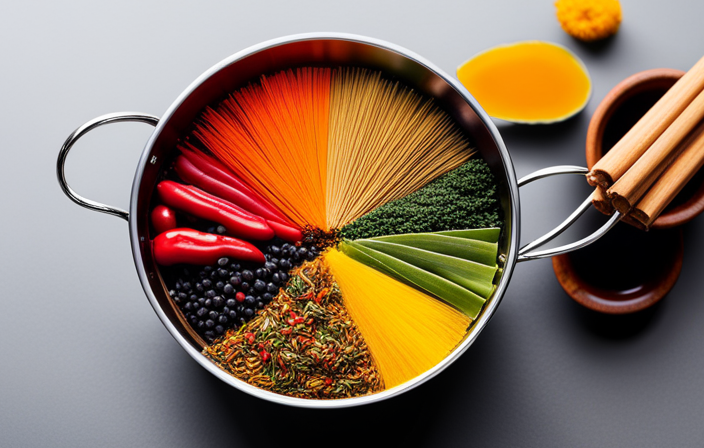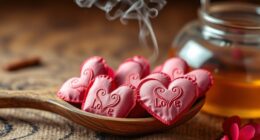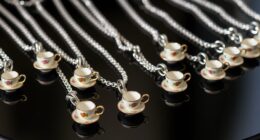Did you know that tea can be used in more ways than just a comforting hot drink?
In fact, there are six innovative ways you can incorporate tea into your cooking to add unique flavors and depth to your dishes.
From tea-infused sauces and dressings to tea-marinated proteins, the possibilities are endless.
Get ready to explore the world of tea-infused cooking and impress your guests with these delicious and unexpected creations.
Let’s dive in and discover the magic of tea in the kitchen!
Key Takeaways
- Tea-infused sauces and dressings can add depth and complexity to dishes, from salads to grilled meats.
- Tea-marinated proteins offer a flavorful twist to traditional meat dishes, making them tender and juicy.
- Using tea as a tenderizer for proteins and vegetables can enhance their tenderness and succulence.
- Tea-infused marinades can create unique flavor profiles, such as citrus and herbs with tea for proteins or floral and zesty combinations for seafood.
Tea-Infused Sauces and Dressings
I love experimenting with tea-infused sauces and dressings in my cooking. It adds a unique and unexpected twist to traditional recipes. One of my favorite creations is a tea-infused salad dressing. By steeping a strong black tea, like Earl Grey or English Breakfast, and combining it with olive oil, balsamic vinegar, honey, and a touch of Dijon mustard, I create a flavorful and aromatic dressing that complements any salad perfectly.
But it doesn’t stop there. Tea can also be used to create a tantalizing BBQ sauce. I like to infuse a smoky Lapsang Souchong tea with ketchup, brown sugar, Worcestershire sauce, and spices like paprika and garlic powder. The result is a tangy, sweet, and slightly smoky sauce that takes grilled meats to a whole new level.
Tea-Marinated Proteins
I love experimenting with different flavors in my cooking. One of my recent discoveries has been tea-marinated proteins. The idea of infusing meat with the unique flavors of tea is intriguing, and the results are absolutely delicious.
Not only does the tea add a distinct taste, but it also helps to tenderize the meat, making it incredibly juicy and flavorful.
Flavorful Tea-Infused Meats
Tea-marinated proteins offer a unique and flavorful twist to traditional meat dishes. By infusing meats with the rich and aromatic flavors of tea, you can elevate your cooking to a whole new level.
Tea-infused rubs are a popular choice to add depth and complexity to your favorite cuts of meat. The tannins in tea act as a natural tenderizer, resulting in tender and juicy meat. Whether you prefer a smoky Lapsang Souchong or a fragrant jasmine tea, there are endless possibilities to experiment with different flavors.
Another technique that has gained popularity is tea smoking meats. This method involves using tea leaves to create a flavorful smoke that infuses the meat with a subtle tea essence. The result is a perfectly cooked, aromatic dish that will leave your guests craving for more.
Tenderizing With Tea
Using tea as a tenderizer enhances the tenderness and succulence of proteins, making it an innovative and versatile ingredient in cooking. Not only does it infuse meats with a delicate flavor, but it also works wonders on vegetables.
Here are three exciting ways to incorporate tea into your cooking:
-
Tea-Infused Beverages: Experiment with brewing your favorite tea and using it as a base for refreshing and unique beverages. From iced teas to tea-infused cocktails, the possibilities are endless.
-
Tea-Infused Vegetables: Steep vegetables in a tea-infused marinade before grilling or roasting them. This technique adds a subtle, aromatic flavor to your veggies, elevating them to a whole new level.
-
Tea-Infused Dressings and Sauces: Enhance the taste of your dressings and sauces by infusing them with tea. Whether it’s a tea-infused vinaigrette or a tea-infused barbecue sauce, your dishes will have a delightful twist.
Unique Marinade Options
One of the most intriguing marinade options for tea-infused proteins is a blend of citrus and herbs, which adds a burst of freshness to the dish. This unique combination not only enhances the flavors of the meat or seafood but also infuses it with the delicate aroma of tea. When marinating vegetables, the tea infusion adds a subtle earthy note that complements their natural flavors. For seafood, the tea infusion brings out the delicate sweetness of the fish or shellfish, creating a truly delightful culinary experience. To give you a better idea, here is a table showcasing some tea-infused marinade options for vegetables and seafood:
| Protein | Tea Infusion | Flavor Profile |
|---|---|---|
| Vegetables | Green tea with mint | Refreshing and herbaceous |
| Seafood | Earl Grey with lavender | Floral and citrusy |
| Seafood | Jasmine tea with lemongrass | Fragrant and zesty |
Experimenting with tea-infused marinades can open up a whole new world of flavors in your cooking. So why not give it a try and surprise your taste buds with the delightful combination of tea and your favorite proteins?
Tea-Infused Baked Goods
I love experimenting with different flavors in my baking. One of my favorite ways to add a unique twist is by infusing tea into my baked goods. Tea brings a whole new dimension to the flavors. Whether it’s a floral jasmine-infused cake or a rich and earthy matcha brownie, the subtle yet distinct taste of tea enhances the overall experience of enjoying these treats. It makes them truly special.
Unique Tea Flavors
Tea flavors like matcha and bergamot offer a plethora of delicious possibilities for creating unique and delectable baked goods. The distinct flavors and aromas of tea can elevate your recipes to a whole new level.
Here are some exciting ways to incorporate different tea blends into your baking:
-
Matcha: This vibrant green tea powder adds a rich, earthy flavor to desserts like macarons, cakes, and cookies. Its natural sweetness and antioxidant properties make it a popular choice.
-
Bergamot: Known for its citrusy and floral notes, bergamot tea is perfect for infusing oils. Use it to make fragrant glazes for cakes or to add depth to buttercream frostings.
-
Earl Grey: With its distinctive blend of black tea and bergamot, Earl Grey tea can be used to create unique flavors in scones, shortbread cookies, and even ice creams.
By experimenting with different tea blends and incorporating them into your baked goods, you can create truly memorable treats that will delight your family, friends, or customers.
Enhancing Baked Goods
Using a variety of tea flavors, I have discovered that adding just a teaspoon of matcha to my cookie dough enhances the flavor and gives it a beautiful green hue. As someone who enjoys serving others through baking, I have found that incorporating tea into my pastries adds a unique twist that elevates the overall taste experience. Tea infused pastries have become a popular trend, offering a delightful blend of familiar flavors with a hint of tea essence. To further enhance the tea-infused goodness, I have also experimented with tea flavored frostings. From Earl Grey buttercream to chamomile glaze, these frostings bring a delightful aroma and taste to any baked creation. Below is a table showcasing some of my favorite tea flavors and their suggested pastry pairings:
| Tea Flavor | Pastry Pairing |
|---|---|
| Matcha | Green Tea Cookies |
| Earl Grey | Lavender Scones |
| Chamomile | Honey Tea Cake |
| Chai | Spiced Chai Cupcakes |
With tea-infused pastries and tea flavored frostings, you can serve up a truly unique and delightful treat that will leave your guests craving for more. So why not embark on this culinary adventure and add a touch of tea to your baking repertoire?
Tea-Infused Soups and Stews
Lately, I’ve been experimenting with incorporating tea flavors into my favorite soups and stews. It’s amazing how a simple infusion of tea can elevate the flavors and add a unique twist to traditional dishes.
Here are a few ways I’ve been using tea in my cooking:
-
Tea-infused broths: Instead of using plain water or stock, I steep tea bags or loose tea leaves in hot water to create a flavorful base for my soups and stews. The earthy notes of black tea or the floral aroma of jasmine tea can add depth and complexity to the dish.
-
Tea-based stews: I’ve also tried using brewed tea as a liquid component in stews. Green tea works particularly well in light and refreshing stews, while smoky black teas complement heartier meat-based stews.
-
Tea-infused spices: Another interesting technique is to infuse spices with tea before adding them to the soup or stew. This imparts a subtle tea flavor to the spices, which then infuses the entire dish.
Tea-infused soups and stews are a delightful way to experiment with flavors and surprise your taste buds. But why stop at savory dishes? Let’s explore the world of tea-infused cocktails and mocktails.
Tea-Infused Cocktails and Mocktails
I love experimenting with different flavors, so incorporating tea into my cocktails and mocktails is a perfect way to add a unique twist to my drinks. Tea infused smoothies and tea infused ice cream are two delightful options that never fail to impress my guests. The infusion of tea adds depth and complexity to these treats, elevating them to a whole new level.
To give you an idea of the possibilities, here is a table showcasing some of my favorite tea-infused creations:
| Tea Infused Smoothies | Tea Infused Ice Cream |
|---|---|
| Matcha Green Tea Smoothie | Earl Grey Lavender Ice Cream |
| Chai Spice Smoothie | Jasmine Green Tea Ice Cream |
| Hibiscus Berry Smoothie | Rooibos Vanilla Ice Cream |
| Peppermint Mocha Smoothie | Chamomile Honey Ice Cream |
| Ginger Turmeric Smoothie | Lemon Ginger Ice Cream |
These combinations not only taste amazing but also provide a refreshing and indulgent experience. So why not try incorporating tea into your next cocktail or mocktail? It’s a simple yet impressive way to elevate your drinks and surprise your guests.
Tea-Infused Desserts
The combination of tea-infused flavors and sweet treats creates a delectable experience that’s both comforting and satisfying. When it comes to tea-infused desserts, there are endless possibilities to tantalize your taste buds. Here are three delightful options to consider:
-
Tea-Infused Ice Cream: Imagine the creamy goodness of ice cream infused with the subtle yet distinct flavors of your favorite tea. Whether it’s Earl Grey, green tea, or chai, this frozen treat is sure to be a hit.
-
Tea-Infused Custards: Rich and velvety, tea-infused custards take dessert to a whole new level. The infusion of tea adds a unique depth of flavor that perfectly complements the smoothness of the custard.
-
Tea-Infused Puddings: From classic favorites like vanilla and chocolate to more adventurous options like matcha or jasmine, tea-infused puddings offer a delightful twist on a beloved dessert.
Indulge in the harmonious blend of tea and dessert, and let your taste buds embark on a truly enchanting culinary journey.
Frequently Asked Questions
How Long Should I Let the Tea Steep Before Using It in a Sauce or Dressing?
When using tea in sauces or dressings, it’s important to let it steep for the right amount of time to extract maximum flavor. The steeping time can vary depending on the type of tea you’re using.
Black teas generally require 3-5 minutes, while green teas need 2-3 minutes. Herbal teas can steep for 5-7 minutes.
As for the best tea varieties, black teas like Earl Grey or English Breakfast work well in savory sauces, while green teas like jasmine or matcha add a unique twist to dressings.
Can I Use Any Type of Tea for Marinating Proteins, or Are There Specific Varieties That Work Best?
Can I use any type of tea for marinating proteins, or are there specific varieties that work best?
When it comes to marinating proteins, different tea varieties can bring unique flavors and aromas. Some teas, like black tea, lend a bold and robust taste, while others, like green tea, offer a lighter and more delicate flavor.
It’s important to consider the protein you’re marinating and choose a tea that complements its natural flavors.
Experimenting with different teas can lead to exciting and innovative culinary experiences.
Are There Any Special Techniques for Incorporating Tea Into Baked Goods Without Affecting the Texture?
When it comes to incorporating tea into baked goods, there are definitely special techniques to consider.
To ensure that the texture of your baked goods isn’t affected, it’s important to infuse the tea into your ingredients properly. This can be done by steeping the tea leaves in your liquid ingredients, like milk or butter, and then incorporating that infused liquid into your batter.
Another option is to use tea flavored glazes, which can add a delicious hint of tea without altering the texture of your baked goods.
Can I Use Tea to Infuse Flavor Into Vegetarian or Vegan Soups and Stews?
Using tea in vegetarian or vegan soups and stews is a fantastic way to infuse unique flavors. Tea can add depth and complexity to your dishes, creating a delightful culinary experience.
There are various techniques to infuse tea into soups, such as steeping it in broth or using it as a seasoning. Experiment with different types of tea, like green tea or herbal blends, to find the perfect flavor combination for your soup recipes.
Get creative and enjoy the wonderful world of tea-infused soups!
What Are Some Creative Ways to Garnish and Serve Tea-Infused Cocktails and Mocktails?
When it comes to garnishing and serving tea-infused cocktails and mocktails, the possibilities are endless! From a sprig of fresh mint to a citrus twist, there are so many creative ways to elevate your drink and impress your guests.
Adding a touch of elegance and flavor to your concoctions, these garnish ideas will surely make your tea-infused mocktails stand out.
So go ahead, experiment with different combinations and let your creativity shine through!
Cheers!
Conclusion
In conclusion, using tea in cooking can add a unique and delightful twist to your dishes. While some may argue that tea might overpower the flavors of other ingredients, it actually enhances and complements them.
Tea can be used in a variety of ways in cooking. From tea-infused sauces and dressings to tea-marinated proteins, baked goods, soups, stews, cocktails, and desserts, the possibilities are endless.
By incorporating tea into your recipes, you can create new and exciting flavors that will surprise and delight your taste buds. So why not give it a try and discover the innovative ways tea can elevate your culinary creations?










